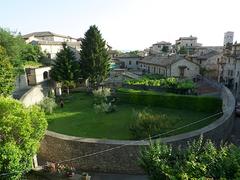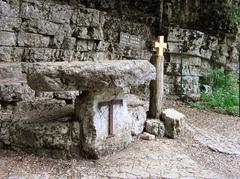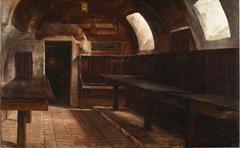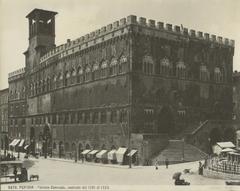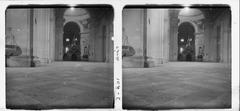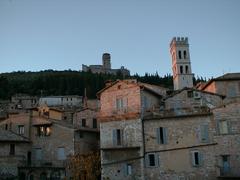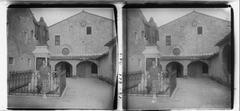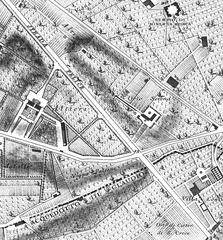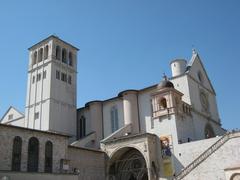Domus del Lararium Assisi: Visiting Hours, Tickets, and Historical Site Guide
Date: 14/06/2025
Introduction
The Domus del Lararium in Assisi, Italy, is a remarkable archaeological site offering a vivid window into the private and spiritual life of the Roman elite. Situated beneath Palazzo Giampè and Palazzo del Cardinale, this well-preserved Roman house reveals centuries of architectural evolution and highlights the central role of household religion in Roman daily life. Through its vibrant frescoes, intricate mosaics, and the namesake lararium (household shrine), the site provides invaluable insight into the art, culture, and spirituality of ancient Assisi (Assisi Serafica Bellezza; Montesubasio.it).
This comprehensive guide covers the Domus del Lararium’s history, artistic highlights, visiting hours, ticketing, accessibility, and travel tips, ensuring a seamless and enriching experience for every visitor.
Table of Contents
- Historical Context
- Archaeological Discovery
- Artistic and Cultural Highlights
- Visiting the Domus del Lararium
- Frequently Asked Questions (FAQ)
- Summary and Resources
Historical Context
Roman Assisi and Urban Development
The Domus del Lararium is located in the southern district of ancient Assisi (Asisium), an area known for its affluent Roman residences. The urban design of Asisium distinguished between public spaces—such as the monumental center with the Temple of Minerva—and residential quarters extending down the hillside (Academia.edu). The proximity of the Domus del Lararium to other significant sites, like the Domus of Propertius, underscores the neighborhood’s prestige during the late Republic and early Empire.
Construction Phases and Chronology
Archaeological research has revealed at least seven distinct phases of construction and renovation, spanning the late 1st century BCE to the 6th century CE. Initial development dates to the late Republican era, with major expansions in the Augustan period and continued occupation through Late Antiquity. Evidence of ongoing modifications—including new mosaics, frescoes, and structural changes—reflects both the evolving tastes of the elite and the site’s enduring importance (Montesubasio.it).
The Lararium and Its Spiritual Role
Central to the house’s identity is the lararium, a shrine dedicated to the Lares, Penates, and other protective deities. The discovery of a terracotta statue of Silvanus—likely placed in the lararium—highlights the intimate connection between daily life and religious practice in Roman homes. The shrine served as the spiritual heart of the domus, where family members performed daily rituals to ensure protection and prosperity (Umbria Cultura; Assisi Serafica Bellezza).
Archaeological Discovery
Circumstances of Excavation
The Domus del Lararium was discovered during post-earthquake restoration and construction works in the 1990s and early 2000s. Excavations beneath Palazzo Giampè and Palazzo del Cardinale unveiled a sprawling domus of over 400 square meters, with at least 13 rooms arranged around a central peristyle (Academia.edu). The overlying medieval and Baroque palaces, constructed on fill rather than on the ancient walls, helped protect the Roman remains.
Layout and Key Features
The domus features a classic Roman layout:
- Atrium: Main reception area for guests.
- Peristyle: Central garden courtyard with original stuccoed brick columns.
- Triclinium: Mosaic-paved dining room for banquets.
- Cubiculum: Bedroom with a frescoed wedding scene and refined mosaic floor.
- Diaeta, Oecus, and Tablinum: Spaces for living, formal dining, and study, adorned with high-quality wall paintings.
Service areas and secondary rooms remain only partially excavated to protect the overlying structures (exploring-umbria.com; assisiitinerari.it).
State of Preservation and Restoration
The site’s underground setting has preserved walls up to four meters high, mosaics, and frescoes in exceptional condition. Restoration efforts focus on stabilizing structures and conserving art, with visitor access limited to elevated walkways to ensure continued protection (Umbria Cultura).
Artistic and Cultural Highlights
Frescoes and Decorative Programs
The domus is renowned for its lavish wall paintings, comparable in quality to those in Rome and Pompeii. Notable features include:
- Pointillist and Figurative Frescoes: Lively figures and mythological motifs (griffins, parrots) in the tablinum and diaeta (assisiitinerari.it).
- Pompeian Red and Ochre Panels: The cubiculum’s frescoes depict nuptial scenes and elegant women (exploring-umbria.com).
Mosaics and Ritual Artifacts
Black-and-white geometric mosaics in local limestone decorate the floors, displaying sophisticated Roman craftsmanship. The lararium, with its altar and terracotta statuette, was found near the cubiculum’s threshold, accompanied by ritual objects such as a marble crescent (oscillum) and personal items like hairpins (Montesubasio.it).
Visiting the Domus del Lararium
Opening Hours and Ticketing
Visits are by guided tour only to protect the fragile remains. As of June 2025, standard tour times are:
- Saturdays at 3:00 PM (year-round)
- Sundays at 3:00 PM (February–May)
- Special openings on select holidays
Tours depart from the IAT Tourist Information Office, Piazza del Comune, 22 (museiparcosubasio.it). Advance booking is highly recommended due to limited group sizes (max 15).
Ticket prices:
- Full price: €10.00
- Reduced: €5.00 (children 7–14, students, over 65s, groups)
- Free: Children under 7, Assisi residents, wheelchair users
Book via:
- Phone: +39 075-8138680
- Email: [email protected]
Tickets are paid at the Tourist Office before the tour.
Accessibility and Guided Tours
The underground nature of the domus limits full accessibility, but viewing platforms are designed to accommodate as many visitors as possible. Tours are available in Italian and English, typically lasting 60–75 minutes.
Visitor tips:
- Wear comfortable footwear and bring a light jacket—the underground climate is cool.
- Arrive 10–15 minutes early to check in.
- Flash photography is prohibited; non-flash photography may be allowed—check with your guide.
Nearby Attractions and Travel Tips
Assisi abounds with historical sites, including the Basilica of Saint Francis, the Roman Forum, and the Temple of Minerva. The central location of the Domus del Lararium makes it easy to include in a broader itinerary. The town offers ample dining, shopping, and accommodation options within walking distance.
Frequently Asked Questions (FAQ)
Q: What are the Domus del Lararium visiting hours?
A: Guided tours are typically Saturdays at 3:00 PM year-round, Sundays at 3:00 PM (February–May), and on select holidays.
Q: How do I book tickets?
A: Reserve in advance by phone (+39 075-8138680) or email ([email protected]). Payment is at the Tourist Office prior to the tour.
Q: Is the site accessible for visitors with disabilities?
A: The site is underground and has limited accessibility, but viewing platforms accommodate most visitors. Contact the site for specific needs.
Q: Are guided tours mandatory?
A: Yes, to protect the site, access is only via guided tour.
Q: Can I take photographs?
A: Flash photography is prohibited, but non-flash photos are often permitted—ask your guide.
Summary and Resources
The Domus del Lararium is a rare archaeological gem showcasing the richness of Roman domestic art, architecture, and spirituality in Assisi. Through guided tours, visitors can safely appreciate its mosaics, frescoes, and lararium shrine while supporting ongoing preservation efforts. Advance booking is essential due to limited capacity.
To enhance your visit, consider downloading the Audiala app for audio guides and real-time updates. Explore other Assisi Roman sites and keep informed via official tourism channels.
Internal Links
External Links
- Official Domus del Lararium site – Montesubasio.it
- Visitor information – Exploring-Umbria.com
- Detailed itinerary – AssisiItinerari.it
- Musei Parco Subasio – Guided tours and reservations
- Umbria Tourism – Assisi Underground
- Hotel Il Duomo – Visit Roman Assisi
- Assisi Serafica Bellezza
- Academia.edu – Academic overview
- Umbria Cultura
For in-depth background on Roman household shrines:
